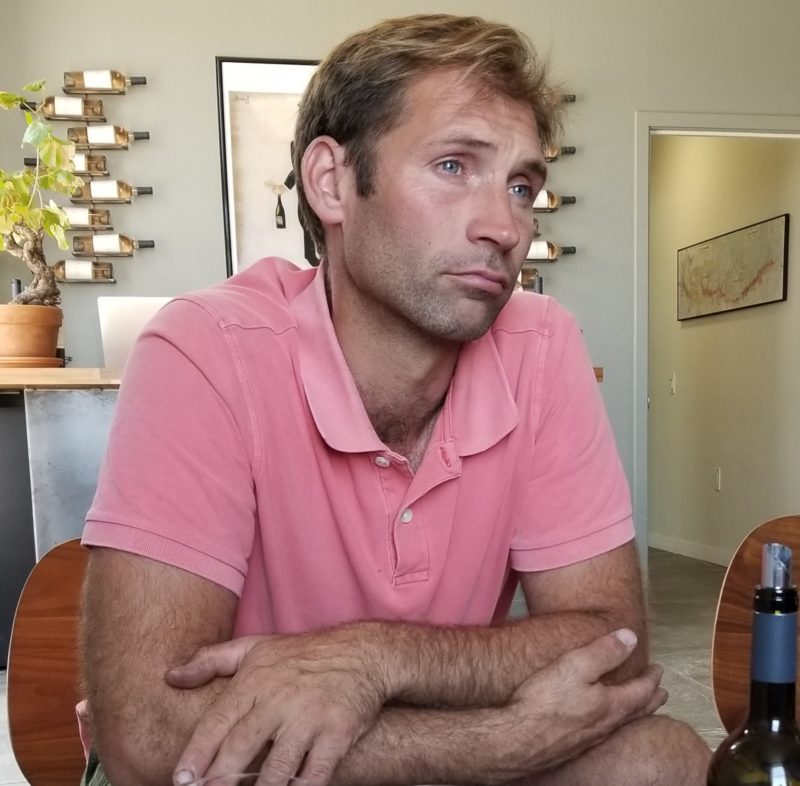As a favor to Guillaume Fabre of Paso Robles’ acclaimed Clos Solene Winery, Terry and I agreed to taste his wine. You know, help a guy out. Actually, since I’ve had them before, I knew they would be tasty.
We started with the 2018 La Rosé, which is 52% grenache, 22% cinsault and 20% mourvedre.
I don’t know if it’s Fabre’s genius or the addition of the cinsault or some combination thereof, but this was the best rose I have ever had. An amazing wine, bright and complex, it smelled like strawberries, tasted like cherries, with a lot of minerality.
Now, $42 for a bottle of rosé is, frankly, a little steep, but after tasting it, I gladly forked over the cash to take a few bottles home. Many times when I’ve taken a bottle home from a winery, it’s simply not as good as at the winery. Well, that was not the case with La Rosé.
It is still delightful back in the Santa Clarita Valley.
Next up was the 2018 Hommage Blanc, which is 75% roussanne and 25% viognier. This treat spent six months in barrel, with little new oak. With a tropical nose and heavy on pineapple, this exceptionally well-balanced Rhone white features tastes of stone fruit and citrus. I want to try this in five years to see how well it’s fulfilled its potential.

According to Fabre, the Fleur de Solene ranks as the winery’s best seller. We tasted both the 2016 and 2017. Fabre imported concrete tanks from Italy to add a different note to his wines. Depending on the vintage, 10 to 20% of the grapes that make up the Fleur de Solene see time in the Italian tanks.
Tasting the same wine from different vintages side by side provides you the opportunity to see how well the wine will age and also to discern how a growing season might influence a wine.
Syrah headlines both the 2016 and 2017 Fleur de Solene. But the No. 2 grape for 2016 was grenache. For 2017, it was cabernet sauvignon. Both have noses of baking spices and blackberry, but the 2016 also boasts cherry fragrances. Of the two, I thought the 2017 was more aromatic.
The 2016 tastes of licorice, blackberry and cherry. The 2017 has more of the blackberry flavors. Fabre ferments his wine at lower temperatures, resulting in round, mellow tannins. But the 2017, because of the cabernet, has heavier tannins. The 2016 is well-balanced with a smooth finish and mellower tannins. You should probably decant either wine for at least one hour. Giving it another three to five years of age would be even better.
We concluded with the 2016 Harmonie, which is made of 68% grenache, 18% mourvedre and 14% syrah. But for California’s wine label laws, you might almost call this a grenache. It is a powerful wine, likely caused by the 20 to 30% whole-cluster, stem inclusion. When you include everything from the vine in fermentation, the result can be an aggressive vino.
This wine reminds me of a meat locker. But, as often happens in a powerful wine, the aromas can be a bit muted in its youth. Swirl it in your glass and hints of berry and slate or rock will bloom.
Terry noted that Fabre’s wines — particularly the Harmonie — are more European in style, meaning that the tastes are more balanced and consistent than some of Paso’s fruit bombs. Being European, food will coax out the nuances of what the wine has to offer. Give this five years, and it will be a knockout.
Clearly, Fabre has benefited from his lengthy lineage of French winemakers, his in-depth wine education, and his tenure with both French and California winemakers. What he offers is not to be missed. In fact, you can meet him in early 2020 when he comes to Santa Clarita to host a wine tasting to benefit the SCV Boys & Girls Club. Be there to be charmed by Fabre and his wines.
Fabre and his brother, Arnaud, own Benom, which has its tasting room in Tin City in Paso Robles. I will discuss these wines in a separate column.
Carl Kanowsky is an attorney, a fledgling baker, an enthusiastic cook and an expert wine drinker.












